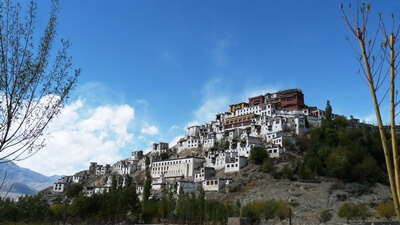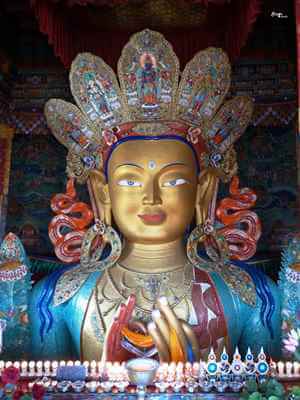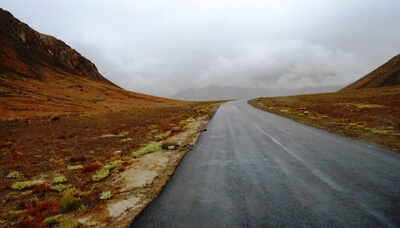Ladakh Sightseeing
Local Leh Sightseeing:
1) Shanti Stupa
Built by the Japanese for World Peace, this magnificent Stupa stands majestically on a hill giving clear views of Leh and surrounding Mountain ranges. A visit early morning climbing its many stairs is an enriching experience. An evening visit is even more special for the Sunset views.
2) Sindhu Ghat
The Ghat is situated at the banks of River Indus and is a center point of one of India’s most important festivals called Sindu Darshan. Its an emotional connect to one of our major ancient rivers and time spent here with your family is soulful experience.
3) Old Town
The Old part of the town has seen many conflicts and many great changes during its age. Old town is a glimpse of Social cultural activities and ladakhi architecture. Its one of the busiest in whole of Leh with all sorts of activities from Monasteries, Mosque, Shopping venues, Govt Offices, Taxi Stand, etc. The town is home to diverse people Muslims, Tibetans, Kashmiris either living or earning livelihood through many shopping venues. Most promient sights are Leh Palace, Namgyal Tsemo Monastery, the Jama Masjid and Leh’s first cinema hall.
4) Gomang Stupa
Situated at Changspa and close to Shanti Stupa in Leh, this is a refreshingly bright chorten built in concentric serrated layers. Its a unique architecural Gompa in a peaceful green setting with a river stream running by. The site has stone carved sculptures that add interest to your visit.
5) Hall of Fame
A small museum in honor of India’s Brave Men who instill the confidence in Ladakhis that their region is safe from any potential dangers. A collection of weapons, memorabilia from India’s wars and showcase of Saichen make up this insightful story of Indian Forces.
7) Spituk Monastery
Situated on a hillock not far from Leh about 7 Kms, Spituk Gompa has a spectacular unique setting bang in the middle of two mighty ranges and on the right bank of river Indus. Spituk Gompa, like all major monasteries has a protected temple also called Kali temple. Try sipping tea at its canteen which has one of the world’s best scenes.
8) Namgyal Gompa
Namgyal Gompa is the most visible ancient structure from Leh center. Built by King Tashi Namgyal in 1430, it has a Buddha Statue (Matrieya) of solid Gold stretching 3 Floors. Just below the Gompa is a Fort in ruins. The view from top gives a clear view of the Leh town.
Monasteries:
Monasteries: The most spectacular part of your whole trip to Leh Ladakh besides the Landscape are the different Monasteries across Ladakh. Most of them sit pretty on a hillock and provide a panaromic view of the surrounding landscape. The Monasteries follow Tibetan Buddhism founded by Guru Padmasambhava. Like most of the beautiful Monasteries across the World, Ladakh has preserved its heritage and those that are in bad shape are being restored. Some of the most notable Monasteries include Hemis, Thikse, Stakna, Likir, Lumayuru, Alchi, Diskit amongst others.
Try visting these Monasteries during different festivals organized by most monasteries on different dates. It will bring you your sacred bliss & blessings. Some of the known and renowned Monasteries:
1) Thiksey Gompa
2) Hemis Gompa
3) Spituk Gompa
4) Stakna Gompa
5) Deskit Gompa
6) Alchi Gompa
7) Basgo Gompa
8) Lekir Gompa
9) Karzok Gompa
Alchi Monastery:
Alchi Monastery complex can be reached by taking a diversion from Kargil Leh Highway. Its about 65Kms west of Leh in Zanskar district and a return day trip can comfortably be undertaken. Built by Rinchen Zangpo the translator. The Monastery in many ways pre dates the many Tibetan style Monasteries in Ladakh. It is one of Ladakh’s Oldest and archeologically one of the most important. Its tall Standing statues with Artwork all over is one of the most spectacular sights amongst all Monasteries. The sacred temples, to be seen there include the Principal one of Buddha Vairocana Lhakhang, Lotsava Lhakhang, the Jamyang Lhakhang (Manjusri temple) and the sumtsag Lhakhang.
The Jamyang Lhakhang (Manjusri temple) consists of two floors supported by pillars that are built in traditional ancient Indian style by sculptours from Kashmir. There are Stupas scattered across the complex and its three villages. Tourist visit this Monastery in large numbers and a traditional market setting has developed around the complex.
Lamayuru Monastery:
Lamayuru Monastery or Yuru Gompa is one of Ladakh’s biggest and busiest. It is 127Kms west of Leh on the Leh-Kargil Highway and close to the so called Moon valley. One isn’t sure about the origins of its initiation but it has its importance both Religiously for its large number of Monks & also culturally for its Festival.
Lamayuru Monastery was supposed to have 5 buildings when it came into existence in early times but today it has only one building left. The Gompa has one assembly hall (Dukhang), the temple (Gonkhang) along with some residential buildings that are there for monks who live here.
The Dukhang walls are beautifully painted with some incredible artistic colorful pictures and images of deities of Buddhists. Gonkhang is the area which has been devoted to Buddhism’s guardians. The temple is quite small but has several images and pictures of Avalokitesvara that is having 11 heads and 1000 arms. Along with Avalokitesvara, the temple also has images of Padmasambhava as well as some statues of 8 Bodhisattvas. One can visit the Monastery enroute to Leh from Kargil. Accommodations are available in plenty for the visitor.
Hemis Monastery:
Situated about 50Kms west of Leh and by the Indus, Hemis Monastery is the richest and one of the biggest in Ladakh. The monastery belongs to Dugpa Kargyutpa order and is built on a green hillside hidden in a gorge. Most of the complex is well maintained and the temples are ornately built. Some of the Artwork and images inside the temples are new and provide a refreshing outlook in terms of space and air.
The Monastery relates to the Gyalwang and Drukpa family. Drukpa is believed to be the sacred image of the Hemis Monastery. The two important elements of the Monastery are Dukhang and Tshongkhang. Many festivals are celebrated in this Monastery. The Hemis fiesta is related to Lord Padmasambhava’s appreciation for the dance performed at this Monastery which showed re-embody of the Buddha. Main attractions of the festival are the striking Masks and the beautiful Tantric dance.
The Monastery also has a Museum providing a rich display of Artifacts.
Thiksey Monstery:
Thiksay Gonmpa is mere 20Kms from Leh and is one of the most beautiful of all monasteries in Ladakh. It belongs to the Gelukpa order. The monastery is also known as ‘Mini Potala’ of India as it resembles the Palace of Potala which is in Lhasa, Tibet. of the Monastery. The monastery is unique in whole of Ladakh for probably the most striking statue of Maitreya (future Buddha) that covers about two floors. Secondly, its provides a spectacular view of the landscape including the Indus river. The Monastery has many temples including protected temple, Tara devi and precious statues & artifacts.
Thiksey along with Hemis are two most spectacular Monasteries west to Leh and be covered in half a day. Other worthwhile Monasteries/Monuments in the same route are Stakna, Stok, Matho & Shey.
Sham Valley:
Sham Valley includes Spituk Monastery, War memorial, Monastery complex at Alchi, Likir Monastery, Basgo Palace, Confluence of Zanskar and Indus, Gurudwara Pather Sahib & Magnetic Hills.This is a 150Kms return trip drive from Leh. The following will provide a brief discription of the list of places on the way:
Spituk Monastery:
Situated about 7 Kms from Leh on a hillock overlooking Leh’s Airport, Spituk is the closest Monastery that is at the outskirts of Leh. Its has a beautiful Main temple and also protected temple (otherwise called Kali temple). The canteen at the entrance provides a panaromic view of the Airport and offers a beautiful view of the landscape. A cup of tea here is a priceless moment.
Gurudwara Pather Sahib:
The Gurudwara is built in the memory of Guru Nanak Dev ji to commerate his visit to the region of Ladakh. Guru Nanak Dev ji is considered a saint even by Ladakhis and has a tibetan name in his honor. The Gurudwara has an interesting history between the demon and Guru ji that adds to the sacredness of this site.
Magnetic Hill:
BRO has a board fixed in Magnetic hills with the banner – “The Phenomenon that defies gravity”. Not sure how tall this claim is but try leaving your Vehicle in Neutral and see what happens. The area here is supposed to have a Magnetic force that can pull cars in either directions.
Confluence of Zanskar and Indus:
Close to Nimmu village, there is confluence of Zanskar and Indus that has become a point of interest to tourists travelling on Leh Kargil road. Its a beautiful sight of two of Ladakh’s most important rivers meeting each other.
Basgo:
Basgo was a political & cultural center 500 years back that was home to Namgyal rulers. Basgo Monastery is of equal importance which is known for its spectacular Murals, Artwork and the Maitreya Buddha Statue. The Monastery is undergoing restoration since the time it was declared a World Heritage site a decade back.
Rizong Monastery:
Rizong Monastery is to the west of Alchi on the way to Lamayuru. It was established in 1831 by Lama Tsultim Nima under the Gelukpa order. The Monastery is reputed for its orthodox style of functioning with strict rules for residing monks. Its known as Paradise for Meditation. Its believed that Guru padmasambhava meditated in the caves here before the Monastery was built.














